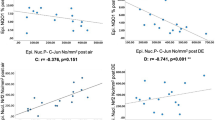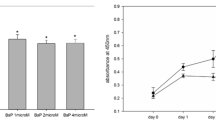Abstract
1,3-Butadiene, an important petrochemical, is commonly burned off when excess amounts need to be destroyed. This combustion process produces butadiene soot (BDS), which is composed of a complex mixture of polycyclic aromatic hydrocarbons in particulates ranging in size from <1 μm to 1 mm. An organic extract of BDS is both cytotoxic and genotoxic to normal human bronchial epithelial (NHBE) cells. Based on the oxidizing potential of BDS, we hypothesized that an organic extract of this particulate matter would (1) cause enzyme inactivation due to protein amino acid oxidation and (2) induce oxidative DNA damage in NHBE cells. Thus, our aims were to determine the effect of butadiene soot ethanol extract (BSEE) on both enzyme activity and the expression of proteins involved in the repair of oxidative DNA damage. Catalase was found to be sensitive to BDS as catalase activity was potently diminished in the presence of BSEE. Using Western analysis, both the alpha isoform of human 8-oxoguanine DNA glycosylase (α-hOGG1) and human apurinic/apyrimidinic endonuclease (APE-1) were shown to be significantly overexpressed as compared to untreated controls after exposure of NHBE cells to BSEE. Our results indicate that BSEE is capable of effectively inactivating the antioxidant enzyme catalase, presumably via oxidation of protein amino acids. The presence of oxidized biomolecules may partially explain the extranuclear fluorescence that is detected when NHBE cells are treated with an organic extract of BDS. Overexpression of both α-hOGG1 and APE-1 proteins following treatment of NHBE cells with BSEE suggests that this mixture causes oxidative DNA damage.





Similar content being viewed by others
Abbreviations
- APE-1:
-
Apurinic/apyrimidinic endonuclease
- BDS:
-
Butadiene soot
- BEAS-2B cells:
-
Immortalized nontumorigenic human bronchial epithelial cells
- BEGM:
-
Bronchial epithelial growth medium
- BSDE:
-
Butadiene soot DMSO extract
- BSEE:
-
Butadiene soot ethanol extract
- DMSO:
-
Dimethyl sulfoxide
- EtOH:
-
Ethanol
- HBE cells:
-
Human bronchial epithelial cells
- hMTH1:
-
Human mutT homologue
- hMYH:
-
Human mutY homolog
- hOGG1:
-
Human 8-oxoguanine DNA glycosylase
- NHBE cells:
-
Normal human bronchial epithelial cells
- 8-oxo-dG:
-
8-oxo-2′-deoxyguanosine
- 8-oxo-dGTP:
-
8-oxo-2′-deoxyguanosine triphosphate
- PAHs:
-
Polycyclic aromatic hydrocarbons
- ROS:
-
Reactive oxygen species
References
Aburatani H, Hippo Y, Ishida T, Takashima R, Matsuba C, Kodama T, et al. Cloning and characterization of mammalian 8-hydroxyguanine-specific DNA glycosylase/apurinic, apyrimidinic lyase, a functional mutM homologue. Cancer Res. 1997;57:2151–6.
Albrecht C, Knaapen AM, Becker A, Hohr D, Haberzettl P, van Schooten FJ, et al. The crucial role of particle surface reactivity in respirable quartz-induced reactive oxygen/nitrogen species formation and APE/Ref-1 induction in rat lung. Respir Res. 2005;2:129. doi:10.1186/1465-9921-6-129.
Brunnemann KD, Kagan MR, Cox JE, Hoffmann D. Determination of benzene, toluene and 1,3-butadiene in cigarette smoke by GC–MDS. Exp Pathol. 1989;37:108–13.
Catallo WJ. Polycyclic aromatic hydrocarbons in combustion residues from 1,3-butadiene. Chemosphere 1998;37:143–57. doi:10.1016/S0045-6535(98)00030-7.
Catallo WJ, Kennedy CH, Henk W, Barker SA, Grace SC, Penn A. Combustion products of 1,3-butadiene are cytotoxic and genotoxic to human bronchial epithelial cells. Environ Health Perspect. 2001;109:965–71. doi:10.2307/3455000.
Cerutti PA. Oxy-radicals and cancer. Lancet 1994;344:862–3. doi:10.1016/S0140-6736(94)92832-0.
Cheng KC, Cahill DS, Kasai H, Nishimura S, Loeb LA. 8-Hydroxyguanine, an abundant form of oxidative DNA damage, causes G→T and A→C substitutions. J Biol Chem. 1992;267:166–72.
Cohen G, Kim M, Ogwu V. A modified catalase assay suitable for a plate reader and for the analysis of brain cell cultures. J Neurosci Methods. 1996;67:53–6. doi:10.1016/0165-0270(96)00011-8.
Demple B, Herman T, Chen DS. Cloning and expression of APE, the cDNA encoding the major human apurinic endonuclease: definition of a family of DNA repair enzymes. Proc Natl Acad Sci USA. 1991;88:11450–4. doi:10.1073/pnas.88.24.11450.
Dreher D, Junod AF. Role of oxygen free radicals in cancer development. Eur J Cancer. 1996;32A:30–8. doi:10.1016/0959-8049(95)00531-5.
Evans AR, Limp-Foster M, Kelley MR. Going APE over ref-1. Mutat Res. 2000;461:83–108.
Grune T, Reinheckel T, Joshi M, Davies KJA. Protein degradation in cultured liver epithelial cells during oxidative stress. J Biol Chem. 1995;270:2344–51. doi:10.1074/jbc.270.5.2344.
Grune T, Reinheckel T, Davies KJA. Degradation of oxidized proteins in mammalian cells. FASEB J. 1997;11:526–34.
Halliwell B, Aruoma OI. DNA damage by oxygen-derived species. Its mechanism and measurement in mammalian systems. FEBS Lett. 1991;28:9–19. doi:10.1016/0014-5793(91)80347-6.
Hashiguchi K, Stuart JA, de Souza-Pinto NC, Bohr VA. The C-terminal αO helix of human Ogg1 is essential for 8-oxoguanine DNA glycosylase activity: the mitochondrial β-Ogg1 lacks this domain and does not have glycosylase activity. Nucleic Acids Res. 2004;32:5596–608. doi:10.1093/nar/gkh863.
He YH 2nd, Wu M, Kobune M, Xu Y, Kelley MR, Martin WJ. Expression of yeast apurinic/apyrimidinic endonuclease (APN1) protects lung epithelial cells from bleomycin toxicity. Am J Respir Cell Mol Biol. 2001;25:692–8.
Hibi K, Liu Q, Beaudry GA, Madden SL, Westra WH, Wehage SL, et al. Serial analysis of gene expression in non-small cell lung cancer. Cancer Res. 1998;58:5690–4.
Iida T, Furuta A, Kawashima M, Nishida J, Nakabeppu Y, Iwaki T. Accumulation of 8-oxo-2′-deoxyguanosine and increased expression of hMTH1 protein in brain tumors. Neuro-oncol 2001;3:73–81. doi:10.1215/15228517-3-2-73.
Kennedy CH, Cueto R, Belinsky SA, Lechner JF, Pryor WA. Overexpression of hMTH1 mRNA: a molecular marker of oxidative stress in lung cancer cells. FEBS Lett. 1998;429:17–20. doi:10.1016/S0014-5793(98)00505-5.
Kennedy CH, Pass HI, Mitchell JB. Expression of human MutT homologue (hMTH1) protein in primary non-small-cell lung carcinomas and histologically normal surrounding tissue. Free Radic Biol Med. 2003;34:1447–57. doi:10.1016/S0891-5849(03)00176-X.
Kim HN, Morimoto Y, Tsuda T, Ootsuyama Y, Hirohashi M, Hirano T, et al. Changes in DNA 8-hydroxyguanine levels, 8-hydroxyguanine repair activity, and hOGG1 and hMTH1 mRNA expression in human lung alveolar epithelial cells induced by crocidolite asbestos. Carcinogenesis 2001;22:265–9. doi:10.1093/carcin/22.2.265.
Kremer TM, Rinne ML, Xu Y, Chen XM, Kelley MR. Protection of pulmonary epithelial cells from oxidative stress by hMYH adenine glycosylase. Respir Res 2004;5:16. doi:10.1186/1465-9921-5-16.
Kuchino Y, Mori F, Kasai H, Inoue H, Iwai S, Miura K, et al. Misreading of DNA templates containing 8-hydroxydeoxyguanosine at the modified base and at adjacent residues. Nature 1987;327:77–9. doi:10.1038/327077a0.
Maki H, Sekiguchi M. MutT protein specifically hydrolyses a potent mutagenic substrate for DNA synthesis. Nature 1992;355:273–5. doi:10.1038/355273a0.
Mambo E, Chatterjee A, de Souza-Pinto NC, Mayard S, Hogue BA, Hoque MO, et al. Oxidized guanine lesions and hOgg1 activity in lung cancer. Oncogene 2005;24:4496–508. doi:10.1038/sj.onc.1208669.
Mo JY, Maki H, Sekiguchi M. Hydrolytic elimination of a mutagenic nucleotide, 8-oxodGTP, by human 18-kilodalton protein: sanitization of nucleotide pool. Proc Natl Acad Sci USA. 1992;89:11021–5. doi:10.1073/pnas.89.22.11021.
Mori Y, Murakami S, Sagae T, Hayashi H, Sakata M, Sagai M, et al. Inhibition of catalase activity in vitro by diesel exhaust particles. J Toxicol Environ Health. 1996;47:125–34. doi:10.1080/009841096161834.
Murphy G Jr, Rouse RL, Polk WW, Henk WG, Barker SA, Boudreaux J, et al. Combustion-derived hydrocarbons localize to lipid droplets in respiratory cells. Am J Respir Cell Mol Biol. 2007. doi:10.1165/rcmb.2007-0204OC.
Nishioka K, Ohtsubo T, Oda H, Fujiwara T, Kang D, Sugimachi K, et al. Expression and differential intracellular localization of two major forms of human 8-oxoguanine DNA glycosylase encoded by alternatively spliced OGG1 mRNAs. Mol Biol Cell. 1999;10:1637–52.
Okamoto K, Toyokuni S, Kim WJ, Ogawa O, Kakehi Y, Arao S, et al. Overexpression of human mutT homologue gene messenger RNA in renal-cell carcinoma: evidence of persistent oxidative stress in cancer. Int J Cancer. 1996;65:437–41. doi:10.1002/(SICI)1097-0215(19960208)65:4<437::AID-IJC7>3.0.CO;2-Y.
Paz-Elizur T, Krupsky M, Elinger D, Schechtman E, Livneh Z. Repair of the oxidative DNA damage 8-oxoguanine as a biomarker for lung cancer risk. Cancer Biomark. 2005;1:201–5.
Penn A, Murphy G, Barker S, Henk W, Penn L. Combustion-derived ultrafine particles transport organic toxicants to target respiratory cells. Environ Health Perspect. 2005;113:956–63.
Puglisi F, Aprile G, Minisini AM, Barbone F, Cataldi P, Tell G, et al. Prognostic significance of Ape1/ref-1 subcellular localization in non-small cell lung carcinomas. Anticancer Res. 2001;21:4041–9.
Reddel RR, Ke Y, Gerwin BI, McMenamin MG, Lechner JF, Su RT, et al. Transformation of human bronchial epithelial cells by infection with SV40 or adenovirus-12 SV40 hybrid virus, or transfection via strontium phosphate coprecipitation with a plasmid containing SV40 early region genes. Cancer Res. 1988;48:1904–9.
Reddel RR, Salghetti SE, Willey JC, Ohnuki Y, Ke Y, Gerwin BI, et al. Development of tumorigenicity in simian virus 40-immortalized human bronchial epithelial cell lines. Cancer Res. 1993;53:985–91.
Rouse RL, Murphy G, Boudreux MJ, Paulsen DB, Penn AL. Soot nanoparticles promote biotransformation, oxidative stress, and inflammation in murine lungs. Am J Respir Cell Mol Biol. 2008. doi:10.1165/rcmb.2008-0057OC.
Shibutani S, Takeshita M, Grollman AP. Insertion of specific bases during DNA synthesis past the oxidation-damaged base 8-oxodG. Nature 1991;349:431–4. doi:10.1038/349431a0.
Shinmura K, Yamaguchi S, Saitoh T, Takeuchi-Sasaki M, Kim SR, Nohmi T, et al. Adenine excisional repair function of MYH protein on the adenine:8-hydroxyguanine base pair in double-stranded DNA. Nucleic Acids Res. 2000;28:4912–8. doi:10.1093/nar/28.24.4912.
Takao M, Aburatani H, Kobayashi K, Yasui A. Mitochondrial targeting of human DNA glycosylases for repair of oxidative DNA damage. Nucleic Acids Res. 1998;26:2917–22. doi:10.1093/nar/26.12.2917.
Toyokuni S, Mori T, Dizdaroglu M. DNA base modifications in renal chromatin of Wistar rats treated with a renal carcinogen, ferric nitrilotriacetate. Int J Cancer 1994;57:123–8. doi:10.1002/ijc.2910570122.
Toyokuni S, Okamoto K, Yodoi J, Hiai H. Persistent oxidative stress in cancer. FEBS Lett. 1995;358:1–3. doi:10.1016/0014-5793(94)01368-B.
Tsurudome Y, Hirano T, Yamato H, Tanaka I, Sagai M, Hirano H, et al. Changes in levels of 8-hydroxyguanine in DNA, its repair and OGG1 mRNA in rat lungs after intratracheal administration of diesel exhaust particles. Carcinogenesis. 1999;20:1573–6. doi:10.1093/carcin/20.8.1573.
Wani G, Milo GE, D’Ambrosio SM. Enhanced expression of the 8-oxo-7,8-dihydrodeoxyguanosine triphosphatase gene in human breast tumor cells. Cancer Lett. 1998;125:123–30. doi:10.1016/S0304-3835(97)00507-7.
Wikman H, Risch A, Klimek F, Schmezer P, Spigelhalder B, Dienemann H, et al. hOGG1 polymorphism and loss of heterozygosity (LOH): significance for lung cancer susceptibility in a caucasian population. Int J Cancer 2000;15:932–7. doi:10.1002/1097-0215(20001215)88:6<932::AID-IJC15>3.0.CO;2-P.
Yang S, Irani K, Heffron SE, Jurnak F, Meyskens FL Jr. Alterations in the expression of the apurinic/apyrimidinic endonuclease-1/redox factor-1 (APE/Ref-1) in human melanoma and identification of the therapeutic potential of resveratrol as an APE/Ref-1 inhibitor. Mol Cancer Ther. 2005;4:1923–35. doi:10.1158/1535-7163.MCT-05-0229.
Zhou H, Cheng B, Lin J. Expression of DNA repair enzyme hMTH1 mRNA and protein in hepatocellular carcinoma. J Huazhong Univ Sci Technolog Med Sci. 2005;25:389–92.
Author information
Authors and Affiliations
Corresponding author
Rights and permissions
About this article
Cite this article
Kennedy, C.H., Catallo, W.J., Wilson, V.L. et al. Combustion products of 1,3-butadiene inhibit catalase activity and induce expression of oxidative DNA damage repair enzymes in human bronchial epithelial cells. Cell Biol Toxicol 25, 457–470 (2009). https://doi.org/10.1007/s10565-008-9100-z
Received:
Accepted:
Published:
Issue Date:
DOI: https://doi.org/10.1007/s10565-008-9100-z




